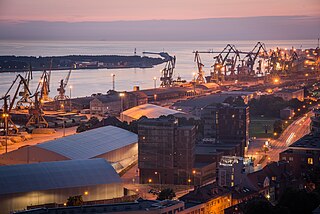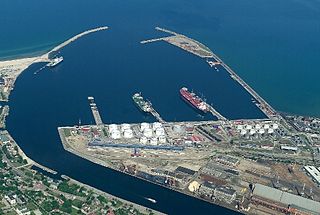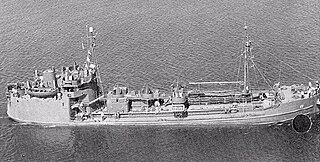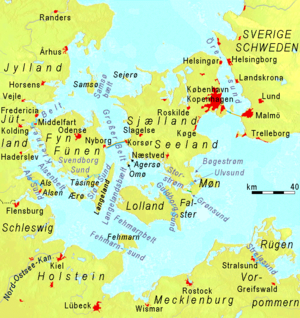
The TTSeawise Giant—earlier Oppama; later Happy Giant, Jahre Viking, Knock Nevis, and Mont—was a ULCC supertanker that was the longest self-propelled ship in history, built in 1974–1979 by Sumitomo Heavy Industries in Yokosuka, Kanagawa, Japan. She possessed the greatest deadweight tonnage ever recorded. Fully laden, her displacement was 657,019 tonnes.

Panamax and New Panamax are terms for the size limits for ships travelling through the Panama Canal. The limits and requirements are published by the Panama Canal Authority (ACP) in a publication titled "Vessel Requirements". These requirements also describe topics like exceptional dry seasonal limits, propulsion, communications, and detailed ship design.

A cargo ship or freighter is a merchant ship that carries cargo, goods, and materials from one port to another. Thousands of cargo carriers ply the world's seas and oceans each year, handling the bulk of international trade. Cargo ships are usually specially designed for the task, often being equipped with cranes and other mechanisms to load and unload, and come in all sizes. Today, they are almost always built of welded steel, and with some exceptions generally have a life expectancy of 25 to 30 years before being scrapped.

A merchant ship, merchant vessel, trading vessel, or merchantman is a watercraft that transports cargo or carries passengers for hire. This is in contrast to pleasure craft, which are used for personal recreation, and naval ships, which are used for military purposes.

A bulk carrier or bulker is a merchant ship specially designed to transport unpackaged bulk cargo—such as grain, coal, ore, steel coils, and cement—in its cargo holds. Since the first specialized bulk carrier was built in 1852, economic forces have led to increased size and sophistication of these ships. Today's bulk carriers are specially designed to maximize capacity, safety, efficiency, and durability.

MT Petali is an Aframax crude oil tanker. Formerly known as Mastera for almost two decades and briefly as Mikines in early 2022 and Alma until September 2023, she and her sister ship Tempera were the first ships to utilize the double acting tanker (DAT) concept in which the vessel is designed to travel ahead in open water and astern in severe ice conditions. The icebreaking tanker was built to transport crude oil year-round from the Russian oil terminal in Primorsk to Neste Oil refineries in Porvoo and Naantali.

La Noumbi is a floating production storage and offloading (FPSO) unit operated by Perenco. The vessel, converted from the former Finnish Aframax crude oil tanker Tempera by Keppel Corporation, will replace an older FPSO unit in the Yombo field off the Republic of Congo in 2018.

A tanker is a ship designed to transport or store liquids or gases in bulk. Major types of tankship include the oil tanker, the chemical tanker, cargo ships, and a gas carrier. Tankers also carry commodities such as vegetable oils, molasses and wine. In the United States Navy and Military Sealift Command, a tanker used to refuel other ships is called an oiler but many other navies use the terms tanker and replenishment tanker. Tankers were first developed in the late 19th century as iron and steel hulls and pumping systems were developed. As of 2005, there were just over 4,000 tankers and supertankers 10,000 LT DWT or greater operating worldwide.

Capesize ships are the largest dry cargo ships with ball mark dimension: about 170,000 DWT capacity, 290 m long, 45 m beam (wide), 18m draught. They are too large to transit the Suez Canal or Panama Canal, and so have to pass either Cape Agulhas or Cape Horn to traverse between oceans.

"Suezmax" is a naval architecture term for the largest ship measurements capable of transiting the Suez Canal in a laden condition, and is almost exclusively used in reference to tankers. The limiting factors are beam, draft, height, and length.

The Bothnian Bay or Bay of Bothnia is the northernmost part of the Gulf of Bothnia, which is in turn the northern part of the Baltic Sea. The land holding the bay is still rising after the weight of ice-age glaciers has been removed, and within 2,000 years the bay will be a large freshwater lake since its link to the south Kvarken is mostly less than 20 metres (66 ft) deep. The bay today is fed by several large rivers, and is relatively unaffected by tides, so has low salinity. It freezes each year for up to six months. Compared to other parts of the Baltic it has little plant or animal life.

Handysize is a naval architecture term for smaller bulk carriers or oil tanker with deadweight of up to 50,000 tonnes, although there is no official definition in terms of exact tonnages. Handysize is also sometimes used to refer to the span of up to 60,000 tons, with the vessels above 35,000 tonnes referred to as Handymax or Supramax.

The Port of Klaipėda is a seaport located in Klaipėda, Lithuania. It is one of the few ice-free ports in northernmost Europe, and the second largest European Union port by tonnage in the Baltic. It serves as a port of call for cruise ships as well as freight transport. Regular passenger ferry lines connect to Kiel, Karlshamn, Copenhagen and other European cities.

The port of Ventspils is an Ice-free, deep-water sea port located in Ventspils on Latvia's Baltic coast. Its total area is 2451.39 hectares. By cargo turnover it is one of the Baltic Sea's busiest ports.

An oil tanker, also known as a petroleum tanker, is a ship designed for the bulk transport of oil or its products. There are two basic types of oil tankers: crude tankers and product tankers. Crude tankers move large quantities of unrefined crude oil from its point of extraction to refineries. Product tankers, generally much smaller, are designed to move refined products from refineries to points near consuming markets.

The history of the oil tanker is part of the evolution of the technology of oil transportation alongside the oil industry.
Ship measurements consist of a multitude of terms and definitions specifically related to ships and measuring or defining their characteristics.

The T1 tanker or T1 are a class of sea worthy small tanker ships used to transport fuel oil before and during World War II, Korean War and Vietnam War. The T1 tanker classification is still in use today. T1 tankers are about 200 to 250 feet in length and are able to sustain a top speed of about 12 knots. The hull designation AO is used by the US Navy to denote the ship is a T1 oil tanker and AOG that the T1 is a gasoline tanker. The small size allows the T1 to enter just about any sea port or to anchor around a small island, this was very useful during the Pacific War. The T1 tanker can carry about 48,000 to 280,000 bbls. Some T1 tankers were used to transport goods other than oil, a few were used for black oil-crude oil, diesel, chemicals and rarely bulk cargo like grain. T1 tankers are also called liquid cargo carriers. The T1 tanker has about a 6,000 to 35,000 deadweight tonnage (DWT) of cargo. The small size also gives the ships short turn around time for repair, cleaning, loading and unloading. A T1 tanker carrying dirty cargo, like crude oil needs a few weeks of labor to clean before carrying clean cargo. Most T1 ships during World War II were named after major oil fields.
Primorsk Port is the largest Russian oil-loading port in the Baltic Sea and the end point of the Baltic Pipeline System. The port is located on the Björkösund mainland of the Gulf of Finland in the Baltic Sea, 5km south-east from the town of Primorsk.

IRIS Makran is the first and only forward base ship of the Islamic Republic of Iran Navy, in service with its Southern Fleet since 2021 and named after a coastal region in southeastern Iran.


















